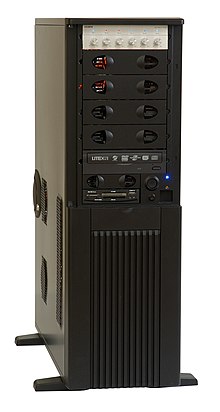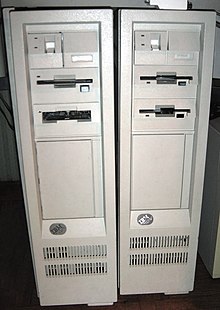
A motherboard is the main printed circuit board (PCB) in general-purpose computers and other expandable systems. It holds and allows communication between many of the crucial electronic components of a system, such as the central processing unit (CPU) and memory, and provides connectors for other peripherals. Unlike a backplane, a motherboard usually contains significant sub-systems, such as the central processor, the chipset's input/output and memory controllers, interface connectors, and other components integrated for general use.

The Tandy 1000 is the first in a line of IBM PC compatible home computer systems produced by the Tandy Corporation for sale in its Radio Shack and Radio Shack Computer Center chains of stores. Introduced in 1984, the product line was aimed at providing affordable but capable systems for home computing or education, with some of its Tandy specific features like graphics, sound and joystick port making it more appealing for home use.

A desktop computer is a personal computer designed for regular use at a stationary location on or near a desk due to its size and power requirements. The most common configuration has a case that houses the power supply, motherboard, disk storage ; a keyboard and mouse for input; and a monitor, speakers, and, often, a printer for output. The case may be oriented horizontally or vertically and placed either underneath, beside, or on top of a desk.
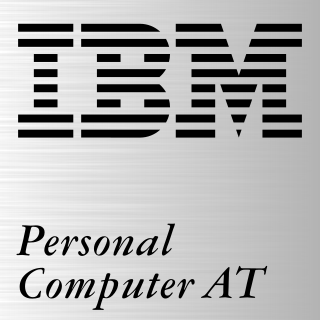
The IBM Personal Computer AT was released in 1984 as the fourth model in the IBM Personal Computer line, following the IBM PC/XT and its IBM Portable PC variant. It was designed around the Intel 80286 microprocessor.

ATX is a motherboard and power supply configuration specification, patented by David Dent in 1995 at Intel, to improve on previous de facto standards like the AT design. It was the first major change in desktop computer enclosure, motherboard and power supply design in many years, improving standardization and interchangeability of parts. The specification defines the dimensions; the mounting points; the I/O panel; and the power and connector interfaces among a computer case, a motherboard, and a power supply.
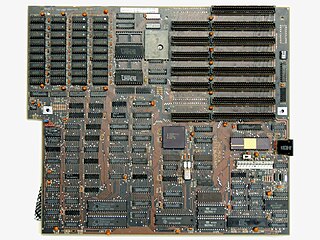
In the era of IBM compatible personal computers, the AT form factor comprises the dimensions and layout of the motherboard for the IBM AT. Baby AT motherboards are a little smaller, measuring 8.5" by 13". Like the IBM PC and IBM XT models before it, many third-party manufacturers produced motherboards compatible with the IBM AT form factor, allowing end users to upgrade their computers for faster processors. The IBM AT became a widely copied design in the booming home computer market of the 1980s. IBM clones made at the time began using AT compatible designs, contributing to its popularity. In the 1990s many computers still used AT and its variants. Since 1997, the AT form factor has been largely supplanted by ATX.

A computer case, also known as a computer chassis, is the enclosure that contains most of the hardware of a personal computer. The components housed inside the case are referred as the internal hardware, while hardware outside the case are known as peripherals.
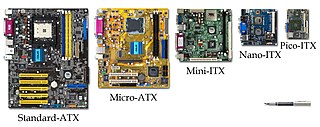
Small form factor is a term used for desktop computers and for some of its components, chassis and motherboard, to indicate that they are designed in accordance with one of several standardized computer form factors intended to minimize the volume and footprint of a desktop computer compared to the standard ATX form factor.

A power supply unit (PSU) converts mains AC to low-voltage regulated DC power for the internal components of a computer. Modern personal computers universally use switched-mode power supplies. Some power supplies have a manual switch for selecting input voltage, while others automatically adapt to the main voltage.

The PS/ValuePoint personal computer was IBM's answer to the PC clone market, where the IBM PS/2 could not compete due to price and proprietary interfaces. Announced in October 1992 and withdrawn in July 1995, it was replaced by the IBM PC Series 300.

The Personal Computer Series, or PC Series, was IBM's follow-up to the Personal System/2 and PS/ValuePoint. Announced in October 1994 and withdrawn in October 2000, it was replaced by the IBM NetVista, apart from the Pentium Pro-based PC360 and PC365, which were replaced by the IBM IntelliStation.
In computing, the motherboard form factor is the specification of a motherboard – the dimensions, power supply type, location of mounting holes, number of ports on the back panel, etc. Specifically, in the IBM PC compatible industry, standard form factors ensure that parts are interchangeable across competing vendors and generations of technology, while in enterprise computing, form factors ensure that server modules fit into existing rackmount systems. Traditionally, the most significant specification is for that of the motherboard, which generally dictates the overall size of the case. Small form factors have been developed and implemented.

The Deskpro 386 is a line of desktop computers in Compaq's Deskpro range of IBM PC compatibles. The computers feature Intel's 32-bit 80386 microprocessor. Introduced in September 1986, the Deskpro 386 is the first implementation of the 80386 processor in a computer system for sale to the public. It also marks the first time that a major component of the IBM Personal Computer de facto standard was updated by a company other than IBM themselves—in this case, upgrading from the 80286 processor of the Personal Computer/AT.

The PS/1 is a brand for a line of personal computers that marked IBM's return to the home market in 1990, five years after the IBM PCjr. It was replaced by the IBM Aptiva in September 1994.
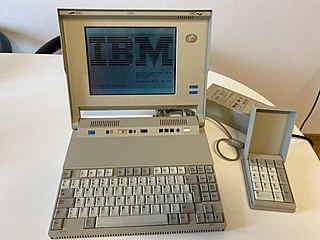
The IBM Personal System/2 Model L40 SX is a portable computer made by IBM as part of the IBM PS/2 series. It was the successor to the IBM PC Convertible. The "SX" in the name refers to its CPU, the Intel 80386SX.
The Tandy 3000 is a personal computer introduced by Radio Shack in 1986 based on the 16-bit 8 MHz Intel 80286 microprocessor.

The Personal System/2 Model 30 and Personal System/2 Model 30 286 are IBM's entry-level desktop computers in their Personal System/2 (PS/2) family of personal computers. As opposed to higher-end entries in the PS/2 line which use Micro Channel bus architecture, the Model 30 features an Industry Standard Architecture bus, allowing it to use expansion cards from its direct predecessors, the PC/XT and the PC/AT. The original PS/2 Model 30 is built upon the Intel 8086 microprocessor clocked at 8 MHz; the Model 30 286 features the Intel 80286 clocked at 10 MHz.

The Personal System/2 Model 25 and its later submodels the 25 286 and 25 SX are IBM's lowest-end entries in the Personal System/2 (PS/2) family of personal computers. Like its sibling the Model 30, the Model 25 features an Industry Standard Architecture bus, allowing it to use expansion cards from its direct predecessors, the PC/XT and the PC/AT—but not from higher entries in the PS/2 line, which use Micro Channel. Unlike all other entries in the PS/2 line, the Model 25 and its submodels are built into an all-in-one form factor, with its cathode-ray tube (CRT) monitor and system board occupying the same enclosure. IBM oriented the Model 25 at home office workers and students.

Cumulus Corporation was an American computer peripheral and system manufacturer active from 1987 to 1993. Based in Beachwood, Ohio and started by Tecmar founder Martin Alpert, the company set out to exclusively manufacture expansion products for IBM's Personal System/2 (PS/2) family of computers—mainly RAM expansion cards. It later released cross-platform CPU upgrade cards and memory expansion cards for other platforms besides the PS/2. Beginning in 1990, the company began trading as Cumulus Computer Corporation and began releasing complete systems of their own. Initially a success story for the tech industry in Cleveland, a botched stock launch in 1992 proved disastrous for the company's ailing cash flow situation, and in 1993 the company was liquidated amid massive debt to suppliers and lenders.

The LTE, LTE/286, and LTE/386s were a series of notebook-sized laptops manufactured by Compaq from 1989 to 1992. The three laptops comprise the first generation of the LTE line, which was Compaq's second attempt at a laptop following the SLT in 1988 and their first attempt at a truly lightweight portable computer. The LTE line proved highly popular—Compaq selling hundreds of thousands of units between the three—and gave way to successive generations of the line, including the LTE Lite, the LTE Elite, and the LTE 5000 series. With its use of industry-standard floppy and hard drive technologies, the LTE was the first commercially successful notebook computer and helped launch the fledgling notebook industry, which had seen earlier attempts fail due to the use of novel but nonstandard data storage.

